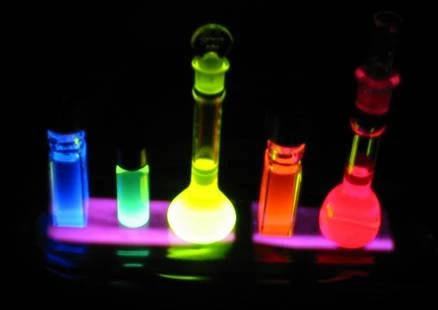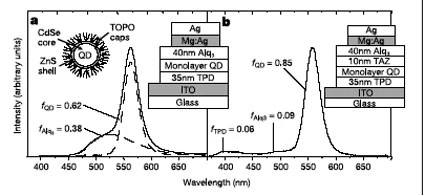November 24, 2004 Designed to foster commercial innovation in the expanding field of nanotechnology, the International Nanotechnology Business Idea Competition provides a glimpse at the diverse range of applications for science on a nano-scale. Among them - and the eventual winner - the next generation of flat panel displays from QD Vision that will use quantum dot light emitting diodes to produce images on flat panel displays via electroluminescence.
QD Vision of Cambridge, Massachusetts was awarded the top prize in the Competition for its idea to produce the next generation of flat panel displays using quantum dot light emitting diodes.
"We couldn't be happier," said Greg Moeller, vice president of sales and marketing for the company. "Winning this competition is going to allow us to secure the intellectual property [behind the company's flat panel displays]." The startup company received $50,000 in cash, plus business plan writing assistance and additional business advisory services in the competition.
Seth Coe-Sullivan, the company's acting chief executive and chief technology officer, is a graduate research assistant at the Massachusetts Institute of Technology, where the technology was developed.
The company will initially target its technology for the hand-held device market. Mobile phones with small colour displays using organic LEDs are already commercially available but QD Vision's flat panel technology uses quantum dot light emitting diodes to produce images on flat panel displays via electroluminescence.
The integration of organic and inorganic materials at the nanometre scale into hybrid optoelectronic structures results in active devices that combine the diversity of organic materials with the high-performance electronic and optical properties of inorganic nanocrystals. Designing hybrid device structures on the nanoscale offers the hope of creating QD-LEDs that have properties unattainable using only organic materials, and efficiencies that make them technologically viable.
Third prizewinner in the International Nanotechnology Business Idea Competition was Cornell DNA Nanobarcodes of Ithaca, N.Y., who are using DNA to build nanostructured materials that can be used as bar codes.
"The DNA Nanobarcode technology is based on the idea of using DNA as a geneRic instead of geneTic material -- this is because there exist a myriad of nano tool kits that can be utilised to manipulate DNA, thus leading to control the structure and architecture of DNA-materials. These tools are not available to other conventional chemicals or materials," says Dan Luo, assistant professor of Biological Engineering in the department of Biological and Environmental Engineering at Cornell University. "We are using DNA nanobarcodes to detect a variety of molecules from basic biology research to environmental monitoring. The technology is built around the conventional equipment (fluorescence detection) so no new equipment is needed to use DNA nanobarcodes," Luo added.
The competition was the concluding event of NANO Week in Cleveland and organised by InTICE: the Institute for Technology Innovation, Commercialisation and Entrepreneurship at Case Western Reserve University; the Nano-Network, a consortium of nanotechnology-minded scientists, entrepreneurs and supporting agencies; and Purdue University.
"I developed the idea for this competition out of frustration that nanotechnology was accused of being either hype or science - not a business," said Mark Brandt, managing partner of the Maple Fund and co-founder of the Nano-Network. "This competition has demonstrated that there are many nano ideas that are ready to be commercialised." The following is a complete list of winners:
First Place - $50,000 QD Vision of Cambridge, Mass., is developing the next generation of flat panel displays using quantum dot light emitting diode devices and associated manufacturing techniques.
Second Place - $15,000 General Lighting of Boston designs low-power, low-cost carbon nanotube-based lighting elements for backlighting in mobile communications products.
Third Place - $10,000 Cornell DNA Nanobarcodes of Ithaca, N.Y., is using DNA to build nanostructured materials that can be used as bar codes.
Five runner-up awards of $1,000 each were also presented to:
Clinical Nanotechnologies Corp. of Columbus, Ohio, is developing the Buccal Patch, which will deliver fast pain relief to cancer patients, and other drug delivery systems.
Y-Carbon of Philadelphia is developing supercapacitors using nanoporous carbon material that can be used to store energy in hybrid vehicles.
Applied Standard of San Francisco is developing nano-based sensors that detect the presence of hydrogen in electrical transformers. The company plans to locate research and development and manufacturing operations in Northeast Ohio to take advantage of existing relationships with the NASA Glenn Research Center/Glennan Microsystems Initiative.
Magnetic BioSystems of Philadelphia has developed a minimally-invasive, targeted drug delivery system that uses stents and magnetic materials.
Alpha V of Chapel Hill, N.C., is commercialising an extremely long-lasting micro-battery to power low-data rate wireless sensors and other small devices.









